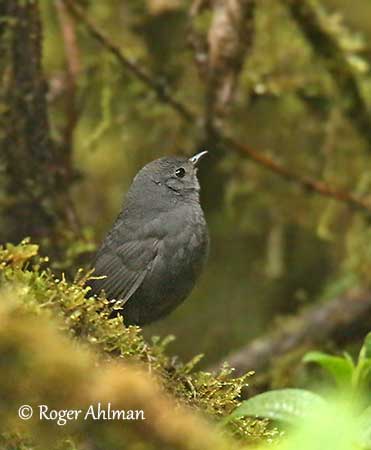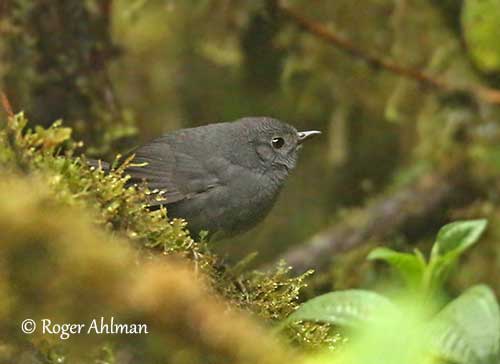
REPRODUCTION OF THIS SPECIES:
A juvenile was collected in August.
The tapaculos of genus Scytalopus build a ball-shaped nest with mosses and plant fibres. This structure is usually built in a cavity such as earth banks or among the roots or the bark of trees.
The female usually lays 2-3 white eggs.
PROTECTION / THREATS / STATUS:
The Tschudi's Tapaculo is considered fairly common throughout the range. It is present in protected areas such as National Parks.
The size of the population is unknown, but it is suspected to be stable as declines or substantial threats are not mentioned.
The Tschudi's Tapaculo is not globally threatened and currently evaluated as Least Concern.
Fr: Mérulaxe de Tschudi
Ang: Tschudi's Tapaculo - Sharp-billed Tapaculo
All: Grautapaculo
Esp: Churrín de Tschudi
Ita: Tapaculo di Tschudi
Nd: Tschudi's Tapaculo
Sd: skiffertapakul
Photographer:
Roger Ahlman
Pbase Galleries Peru and Ecuador
Text by Nicole Bouglouan
Sources:
HANDBOOK OF THE BIRDS OF THE WORLD Vol 8 By Josep del Hoyo-Andrew Elliott-David Christie - Lynx Edicions - ISBN: 8487334504
BIRDS OF SOUTH AMERICA – Passerines - by Robert S. Ridgely and Guy Tudor – HELM Field Guides – ISBN: 9781408113424
BIRDS OF PERU by Thomas S. Schulenberg, Douglas F. Stotz, Daniel F. Lane, John P. O’Neill, Theodore A. Parker III –Princeton University Press 2007– ISBN: 978-0-691-13023-1
Neotropical Birds – Cornell Lab of Ornithology
Fat birder - Rhinocryptidae – Tapaculos
Wikipedia, la enciclopedia libre
Wikipedia, the free encyclopaedia
Tschudi’s Tapaculo
Scytalopus acutirostris
Passeriformes Order – Rhinocryptidae Family
INTRODUCTION:
The Tschudi's Tapaculo is endemic to C Peru where it frequents the undergrowth of the upper mountain forest on the E slope of the Andes, between 2,700 and 3,400 metres of elevation.
It feeds on small invertebrates caught in the dense undergrowth. The breeding biology of the species is poorly known.
The Tschudi's Tapaculo is described as fairly common and the species is not currently globally threatened.
The name of this species pays tribute to Johann Jakob von Tschudi, a Swiss naturalist, explorer and diplomat who was among the first European naturalists to explore the Andes of Peru where this species has been encountered.
DESCRIPTION OF THE BIRD:
Biometrics:
Length: 10-11 cm
Weight: M: 17-20 g – F: 16,5-19 g
The Tschudi's Tapaculo is fairly small. The male’s plumage is dark grey to blackish depending on the light. The underparts are paler grey with the flanks slightly washed with brownish and some traces of barring.
The thin bill is black. The eyes are dark brown. Legs and feet are dark brownish.

The female is paler overall. The rump is tinged brown and on the dark dusky brown wings, the inner flight-feathers have subterminal black or tawny bars.
On the underparts, flanks and vent are black with tawny brown barring.
The juvenile is mostly grey-brown with dark bars and spots.
RANGE:
The Tschudi's Tapaculo is found in C Andes of Peru, from S Amazonas S to Junín.
HABITAT:
The Tschudi's Tapaculo frequents the undergrowth of humid montane forest, usually between 2,700 and 3,400 metres of elevation.
CALLS AND SONGS: SOUNDS BY XENO-CANTO
The Tschudi's Tapaculo utters loud and stereotyped calls and songs that help to identify them, because the members of this genus are very similar to each other in both plumage and overall appearance.
The call of the present species is a monotonous series of 3-7 descending notes repeated at 3-4 seconds intervals.
The song is a short trill repeated about 5-10 times or more, interspersed with a pause.
BEHAVIOUR IN THE WILD:
The Tschudi's Tapaculo feeds primarily on tiny insects, but some seeds and berries may occasionally be part of its diet too.
It forages by gleaning prey from moss, litter and earth while moving quickly in the undergrowth or on the ground, in mouse-like action. The tail is usually cocked above the back.
The breeding behaviour of this species is poorly known. The nest is a ball-shaped structure made with plant material and usually built in a cavity.
The Tschudi's Tapaculo is probably sedentary.
The long legs are well-adapted to its terrestrial habits, while the short, rounded wings indicate that the bird is a poor flier that only moves over short distance.
